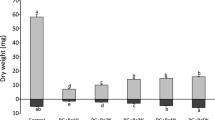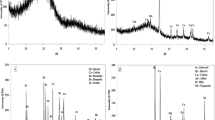Abstract
Soil pollution by metal(loid)s is an important issue in Europe, as it causes environmental and health problems. Therefore, remediation of these areas is needed. The success of phytoremediation process will depend on the ability of plants to implement, which can require the addition of amendments to the soil in order to improve soil conditions, immobilize pollutant and thus ameliorate plant growth. Amendments that can be used are biochar, activated carbon and redmuds, all of which have previously shown positive outcomes. The objectives of this study were to evaluate the effects of several amendments (biochars, activated carbons and redmuds) on (i) the soil physico-chemical properties of a former mine technosol contaminated by As and Pb, (ii) As and Pb immobilization and (iii) the growth of Trifolium repens. Results showed that amendment addition could ameliorate soil conditions, by reducing soil acidity (pH increased by 1.2 to 1.7 units) and immobilizing pollutants (85 to 99% of Pb immobilized); and improve plant growth (dry weight increased 1.5 to 2.5 times). However, not all amendments were beneficial to the soil and plant. For instance, the L27 activated carbon acidified soil pH, mobilized As and lowered plant growth. This study has allowed us to conclude that amendment effect is dependent on soil type, metal(loid)s and amendment properties, and it is thus necessary to choose the right amendment. Finally, amendments could be combined for better outcomes.




Similar content being viewed by others
References
Ahirwal J, Maiti SK (2018) Development of Technosol properties and recovery of carbon stock after 16 years of revegetation on coal mine degraded lands, India. CATENA 166:114–123
Beesley L, Inneh O, Norton G, Moreno-Jimenez E, Pardo T, Clemente R, Dawson J (2014) Assessing the influence of compost and biochar amendments on the mobility and toxicity of metals and arsenic in a naturally contaminated mine soil. Environ Pollut 186:195–202
Bidar G, Pruvot C, Garçon G, Verdin A, Shirali P, Douay F (2009) Seasonal and annual variations of metal uptake, bioaccumulation, and toxicity in Trifolium repens and Lolium perenne growing in a heavy metal-contaminated field. Environ Sci Pollut Res 16(1):42–53
Břendová K, Zemanová V, Pavlíková D, Tlustoš P (2016) Utilization of biochar and activated carbon to reduce Cd, Pb and Zn phytoavailability and phytotoxicity for plants. J Environ Manage 181:637–645
Briffa J, Sinagra E, Blundell R (2020) Heavy metal pollution in the environment and their toxicological effects on humans. Heylion 6:e04691
Carré F, Caudeville J, Bonnard R, Bert V, Boucard P, Ramel M (2017) Soil contamination and human health: a major challenge for global soil security. In: Global Soil Security (pp. 275–295). Springer, Cham.
El-Naggar A, Lee SS, Awad YM, Yang X, Ryu C, Rizwan M, Rinklebe J, Tsang DCW, Ok YS (2018) Influence of soil properties and feedstocks on biochar potential for carbon mineralization and improvement of infertile soils. Geoderma 332:100–108
El-Naggar A, Lee MH, Hur J, Lee YH, Igalavithana AD, Shaheen SM, Ryu C, Rinklebe J, Tsang DCW, Ok YS (2020) Biochar-induced metal immobilization and soil biogeochemical process: an integrated mechanistic approach. Sci Total Environ 698:134112
Gautam PK, Gautam RK, Banerjee S, Chattopadhyaya MC, Pandey JD (2016) Heavy metals in the environment: fate, transport, toxicity and remediation technologies. Nova Sci Publish 60:101–130
Hattab-Hambli N, Lebrun M, Miard F, Le Forestier L, Bourgerie S, Morabito D (2020) Preliminary characterization of a post-industrial soil for long-term remediation by phytomanagement: mesocosm study of its phytotoxicity before field application. Inter J Environ Res 14(1):93–105.
Heidarinejad Z, Dehghani MH, Heidari M, Javedan G, Ali I, Sillanpää M (2020) Methods for preparation and activation of activated carbon: a review. Environ Chem Lett 14:1–23
Hurel C, Taneez M, Ghirardini AV, Libralato G (2017) Effects of mineral amendments on trace elements leaching from pre-treated marine sediment after simulated rainfall events. Environ Pollut 220:364–374
Ippolito JA, Berry CM, Strawn DG, Novak JM, Levine J, Harley A (2017) Biochars reduce mine land soil bioavailable metals. J Environ Qual 46(2):411–419
Khairul MA, Zanganeh J, Moghtaderi B (2019) The composition, recycling and utilisation of Bayer red mud. Resour Conserv Recycl 141:483–498
Kumar A, Bhattacharya T (2021a) Biochar: a sustainable solution. Environ Dev Sustain 23:6642–6680. https://doi.org/10.1007/s10668-020-00970-0
Kumar A, Bhattacharya T (2021b) Removal of arsenic by wheat straw biochar from soil. Bull Environ Contam Toxicol. https://doi.org/10.1007/s00128-020-03095-2
Kumar A, Bhattacharya T, Hasnain SM, Nayak AK, Hasnain S (2020) Applications of biomass-derived materials for energy production, conversion, and storage. Mater Sci Energ Technol 3:905–920
Lacalle RG, Becerril JM, Garbisu C (2020) Biological methods of polluted soil remediation for an effective economically-optimal recovery of soil health and ecosystem services. J Environ Sci Public Health 4:112–133
Lebrun M, Miard F, Nandillon R, Hattab-Hambli N, Scippa GS, Bourgerie S, Morabito D (2018) Eco-restoration of a mine technosol according to biochar particle size and dose application: study of soil physico-chemical properties and phytostabilization capacities of Salix viminalis. J Soils Sediments 18(6):2188–2202
Lebrun M, Miard F, Nandillon R, Scippa GS, Bourgerie S, Morabito D (2019) Biochar effect associated with compost and iron to promote Pb and As soil stabilization and Salix viminalis L. growth. Chemosphere 222:810–822
Lebrun M, Van Poucke R, Miard F, Scippa GS, Bourgerie S, Morabito D, Tack FM (2020) Effects of carbon‐based materials and redmuds on metal (loid) immobilization and growth of Salix dasyclados Wimm. on a former mine technosol contaminated by arsenic and lead. Land Degrad Dev 32(1), 467–481
Li H, Dong X, da Silva E, de Oliveira L, Chen Y, Ma L (2017) Mechanisms of metal sorption by biochars: biochar characteristics and modifications. Chemosphere 178:466–478
Lin H, Liu C, Li B, Dong Y (2020) Trifolium repens L. regulated phytoremediation of heavy metal contaminated soil by promoting soil enzyme activities and beneficial rhizosphere associated microorganisms. J Hazard Mater 402:123829
Liu H, Xu F, Xie Y, Wang C, Zhang A, Li L, Xu H (2018) Effect of modified coconut shell biochar on availability of heavy metals and biochemical characteristics of soil in multiple heavy metals contaminated soil. Sci Total Environ 645:702–709
Liu C, Lin H, Li B, Dong Y, Yin T (2020) Responses of microbial communities and metabolic activities in the rhizosphere during phytoremediation of Cd-contaminated soil. Ecotoxicol Environ Saf 202:110958
Lopes G, Ferreira PAA, Pereira FG, Curi N, Rangel WM, Guilherme LRG (2016) Beneficial use of industrial by-products for phytoremediation of an arsenic-rich soil from a gold mining area. Int J Phytorem 18(8):777–784
Luo L, Ma C, Ma Y, Zhang S, Lv J, Cui M (2011) New insights into the sorption mechanism of cadmium on red mud. Environ Pollut 159(5):1108–1113
Muthusaravanan S, Sivarajasekar N, Vivek JS, Paramasivan T, Naushad M, Prakashmaran J, Gayathri V, Al-Duaij OK (2018) Phytoremediation of heavy metals: mechanisms, methods and enhancements. Environ Chem Lett 16(4):1339–1359
Nanda S, Dalai AK, Berruti F, Kozinski JA (2016) Biochar as an exceptional bioresource for energy, agronomy, carbon sequestration, activated carbon and specialty materials. Waste Biomass Valorizat 7(2):201–235
Nandillon R, Lahwegue O, Miard F, Lebrun M, Gaillard M, Sabatier S, Battalia-Brunet F, Morabito D, Bourgerie S (2019) Potential use of biochar, compost and iron grit associated with Trifolium repens to stabilize Pb and As on a multi-contaminated technosol. Ecotoxicol Environ Saf 182:109432
Nejad ZD, Jung MC (2017) The effects of biochar and inorganic amendments on soil remediation in the presence of hyperaccumulator plant. Int J Energy Environ Eng 8(4):317–329
O’Connor D, Peng T, Zhang J, Tsang DC, Alessi DS, Shen Z, Bolan NS, Hou D (2018) Biochar application for the remediation of heavy metal polluted land: a review of in situ field trials. Sci Total Environ 619:815–826
Paz-Ferreiro J, Lu H, Fu S, Méndez A, Gascó G (2014) Use of phytoremediation and biochar to remediate heavy metal polluted soils: a review. Solid Earth 5(1):65–75
Que W, Zhou YH, Liu YG, Wen J, Tan XF, Liu SJ, Jiang LH (2019) Appraising the effect of in-situ remediation of heavy metal contaminated sediment by biochar and activated carbon on Cu immobilization and microbial community. Ecol Eng 127:519–526
R Core Team (2017) R: a language and environment for statistical computing. R Foundation for Statistical Computing, Vienna. URL https://www.R-project.org/.
Radziemska M, Bęś A, Gusiatin ZM, Cerdà A, Mazur Z, Jeznach J, Kowal P, Brtnický M (2019) The combined effect of phytostabilization and different amendments on remediation of soils from post-military areas. Sci Total Environ 688:37–45
Rahman MS, Clark MW, Yee LH, Comarmond MJ, Payne TE, Burton ED (2019) Effects of pH, competing ions and aging on arsenic (V) sorption and isotopic exchange in contaminated soils. Appl Geochem 105:114–124
Rubinos DA, Spagnoli G (2019) Assessment of red mud as sorptive landfill liner for the retention of arsenic (V). J Environ Manage 232:271–285
Shah V, Daverey A (2020) Phytoremediation: a multidisciplinary approach to clean up heavy metal contaminated soil. Environ Technol Innovat 18:100774
Shahbaz AK, Iqbal M, Jabbar A, Hussain S, Ibrahim M (2018) Assessment of nickel bioavailability through chemical extractants and red clover (Trifolium pratense L.) in an amended soil: Related changes in various parameters of red clover. Ecotoxicol Environ Saf 149:116–127
Sharma A, Nagpal AK (2018) Soil amendments: a tool to reduce heavy metal uptake in crops for production of safe food. Rev Environ Sci Biotechnol 17(1):187–203
Shin WS, Kang K, Kim YK, Shin WS, Kang K, Kim YK (2014) Adsorption characteristics of multi-metal ions by red mud, zeolite, limestone, and oyster shell. Environ Eng Res 19(1):15–22
Simiele M, Lebrun M, Miard F, Trupiano D, Poupart P, Forestier O, Scippa GS, Bourgerie D, Morabito D (2020) Assisted phytoremediation of a former mine soil using biochar and iron sulphate: Effects on As soil immobilization and accumulation in three Salicaceae species. Sci Total Environ 710:136203
Van Poucke R, Allaert S, Ok YS, Pala M, Ronsse F, Tack FMG, Meers E (2019) Metal sorption by biochars: A trade-off between phosphate and carbonate concentration as governed by pyrolysis conditions. J Environ Manage 246:496–504
Wang X P, Shan X Q, Zhang S Z, Wen B (2004) A model for evaluation of the phytoavailability of trace elements to vegetables under the field conditions. Chemosphere 55(6):811–822
Wang Y, Liu Y, Zhan W, Zheng K, Wang J, Zhang C, Chen R (2020) Stabilization of heavy metal-contaminated soils by biochar: challenges and recommendations. Sci Total Environ 729:139060
Wang Y, Zhong B, Shafi M, Ma J, Guo J, Wu J, Ye Z, Liu D, Jin H (2019) Effects of biochar on growth, and heavy metals accumulation of moso bamboo (Phyllostachy pubescens), soil physical properties, and heavy metals solubility in soil. Chemosphere 219:510–516
Wang Y, Li F, Song J, Xiao R, Luo L, Yang Z, Chai L (2018) Stabilization of Cd-, Pb-, Cu-and Zn-contaminated calcareous agricultural soil using red mud: a field experiment. Environ Geochem Health 40(5):2143–2153
Yadav KK, Gupta N, Kumar A, Reece LM, Singh N, Rezania S, Khan SA (2018) Mechanistic understanding and holistic approach of phytoremediation: a review on application and future prospects. Ecol Eng 120:274–298
Acknowledgements
The authors wish to thank La Carbonerie (JC Léger), Jacobi Carbons (G Fiorentino) and Alteo Environnement for providing the amendments.
Author information
Authors and Affiliations
Corresponding author
Additional information
Publisher's Note
Springer Nature remains neutral with regard to jurisdictional claims in published maps and institutional affiliations
Supplementary Information
Below is the link to the electronic supplementary material.
Rights and permissions
About this article
Cite this article
Lebrun, M., Bourgerie, S. & Morabito, D. Effects of Different Biochars, Activated Carbons and Redmuds on the Growth of Trifolium repens and As and Pb Stabilization in a Former Mine Technosol. Bull Environ Contam Toxicol 108, 403–414 (2022). https://doi.org/10.1007/s00128-021-03271-y
Received:
Accepted:
Published:
Issue Date:
DOI: https://doi.org/10.1007/s00128-021-03271-y




